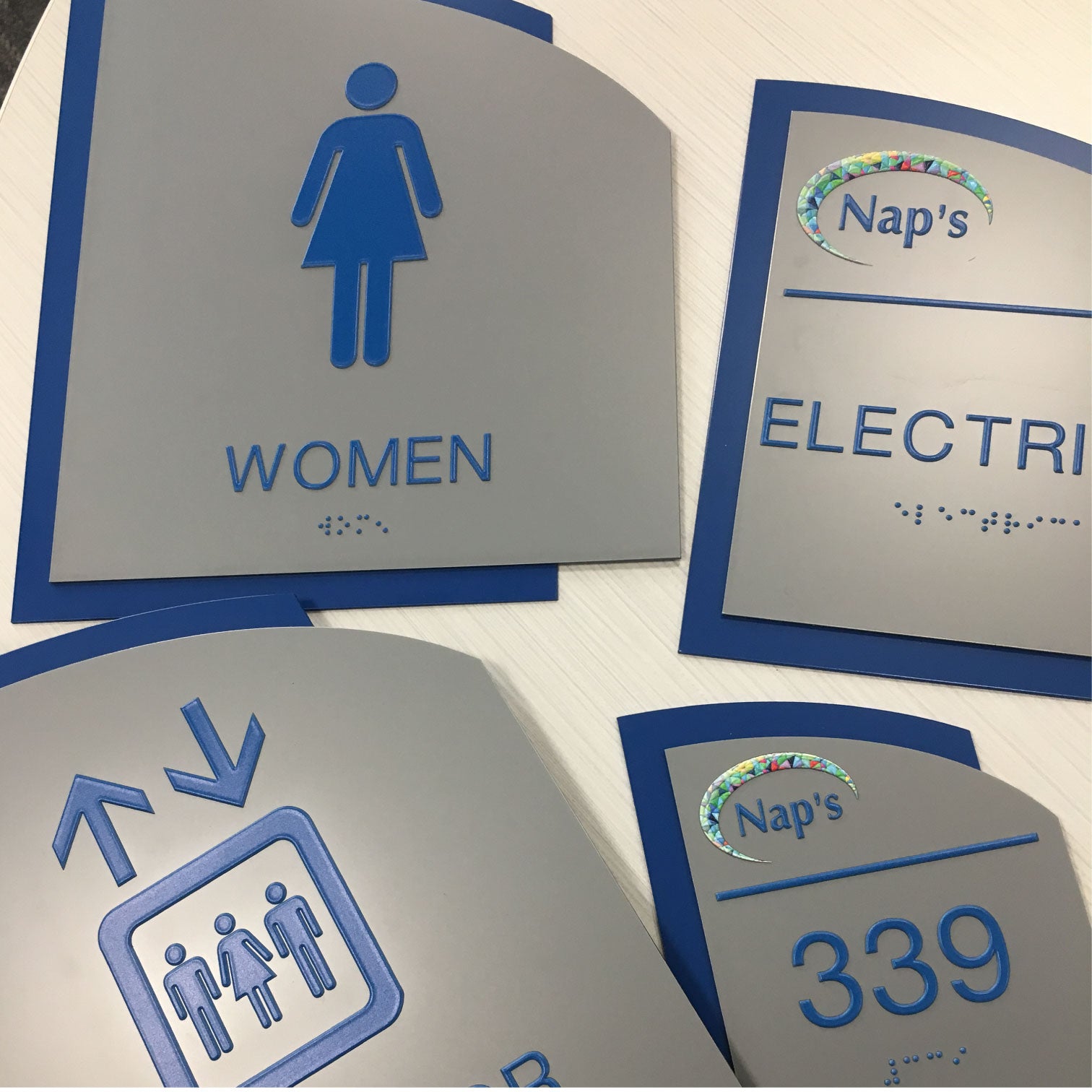The Duty of ADA Signs in Following Access Specifications
The Duty of ADA Signs in Following Access Specifications
Blog Article
Discovering the Key Features of ADA Indicators for Enhanced Accessibility
In the world of accessibility, ADA indicators work as silent yet powerful allies, making sure that areas are navigable and inclusive for individuals with handicaps. By incorporating Braille and tactile aspects, these indications damage barriers for the aesthetically damaged, while high-contrast color plans and understandable font styles deal with varied visual requirements. Their tactical positioning is not arbitrary yet instead a calculated effort to assist in seamless navigation. Beyond these features exists a much deeper story about the evolution of inclusivity and the continuous dedication to producing fair spaces. What extra could these signs signify in our pursuit of universal accessibility?
Value of ADA Compliance
Making sure conformity with the Americans with Disabilities Act (ADA) is vital for fostering inclusivity and equal access in public areas and work environments. The ADA, established in 1990, mandates that all public facilities, employers, and transport solutions accommodate individuals with impairments, guaranteeing they enjoy the very same legal rights and chances as others. Compliance with ADA requirements not only satisfies lawful responsibilities yet additionally enhances an organization's credibility by showing its dedication to variety and inclusivity.
Among the key aspects of ADA conformity is the execution of accessible signage. ADA signs are designed to make sure that people with handicaps can conveniently browse via structures and areas. These indications should stick to details standards relating to size, font style, shade contrast, and placement to guarantee presence and readability for all. Properly executed ADA signage helps remove obstacles that people with specials needs usually run into, consequently advertising their self-reliance and self-confidence (ADA Signs).
Moreover, sticking to ADA guidelines can reduce the threat of prospective fines and lawful consequences. Organizations that fail to abide with ADA guidelines might encounter suits or fines, which can be both harmful and monetarily troublesome to their public image. Hence, ADA compliance is indispensable to fostering a fair setting for everyone.
Braille and Tactile Elements
The unification of Braille and tactile aspects right into ADA signage personifies the principles of availability and inclusivity. These attributes are vital for individuals that are aesthetically impaired or blind, allowing them to navigate public spaces with higher freedom and confidence. Braille, a responsive writing system, is important in supplying created information in a style that can be easily viewed with touch. It is usually put under the corresponding text on signage to guarantee that people can access the information without aesthetic help.
Tactile elements expand beyond Braille and include raised icons and personalities. These parts are made to be noticeable by touch, enabling individuals to identify room numbers, washrooms, exits, and various other essential locations. The ADA sets specific guidelines pertaining to the dimension, spacing, and placement of these responsive components to enhance readability and make sure consistency across different settings.

High-Contrast Shade Plans
High-contrast color systems play a critical role in boosting the presence and readability of ADA signage for people with visual problems. These schemes are vital as they make the most of the distinction in light reflectance between text and background, guaranteeing that indicators are quickly noticeable, even from a range. The Americans with Disabilities Act (ADA) mandates using particular shade contrasts to accommodate those with restricted vision, making it an essential facet of compliance.
The efficiency of high-contrast colors exists in their ability to stick out in numerous illumination problems, including poorly lit settings and areas with glare. Commonly, dark text on a light background or light message on a dark history is employed to achieve optimum contrast. Black message on a yellow or white background offers a raw visual distinction that assists in quick acknowledgment and comprehension.

Legible Fonts and Text Size
When considering the layout of ADA signage, the option of clear typefaces and proper text dimension can not be overstated. The Americans with Disabilities Act (ADA) mandates that fonts need to be not italic and sans-serif, oblique, manuscript, very ornamental, or of uncommon kind.
According to ADA guidelines, the minimal message elevation ought to be 5/8 inch, and it needs to raise proportionally with seeing range. Consistency in message size adds to a natural aesthetic experience, helping individuals in browsing settings effectively.
Additionally, spacing in between lines and letters is integral to readability. Ample spacing protects against characters from find this showing up crowded, boosting readability. By adhering to these criteria, designers can significantly improve accessibility, making certain that additional info signs offers its desired purpose for all people, no matter their aesthetic capacities.
Effective Placement Strategies
Strategic positioning of ADA signs is essential for maximizing access and ensuring compliance with legal requirements. ADA standards specify that signs ought to be mounted at an elevation between 48 to 60 inches from the ground to ensure they are within the line of sight for both standing and seated individuals.
Additionally, indicators need to be positioned surrounding to the lock side of doors to permit easy identification prior to entrance. Uniformity in sign placement throughout a center enhances predictability, minimizing complication and enhancing general customer experience.

Verdict
ADA indicators play a crucial role in promoting accessibility by incorporating features that resolve the demands of individuals with handicaps. These components jointly cultivate an inclusive environment, highlighting the value of ADA compliance in making sure equal access for all.
In the realm of ease of access, ADA indications serve as silent yet effective allies, guaranteeing that spaces are navigable and inclusive for individuals with handicaps. The ADA, passed in 1990, mandates that all public facilities, companies, and transport solutions right here fit individuals with specials needs, ensuring they appreciate the exact same legal rights and opportunities as others. ADA Signs. ADA signs are developed to ensure that individuals with handicaps can easily navigate through areas and structures. ADA guidelines specify that signs must be placed at a height between 48 to 60 inches from the ground to ensure they are within the line of sight for both standing and seated individuals.ADA indicators play a vital role in promoting ease of access by incorporating attributes that deal with the needs of people with disabilities
Report this page